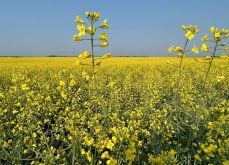Perennial cereal rye, a new forage crop in Canada, shows tremendous promise as an alternative to barley silage for Western Canada’s beef industry, say researchers at Agriculture Canada’s Lethbridge Research Centre.
Known as PC rye, the crop is the result of a cross between an annual rye and a perennial grass, says forage breeder Surya Acharya. PC rye has similar feed quality to barley, with several advantages because of its high yield, rapid maturity and perennial nature.
“PC rye has generated a lot of interest from the beef industry because of its many economic and environmental benefits,” Acharya said.
Read Also

StatCan stands by its model-based crop forecast
Statistics Canada’s model-based production estimates are under scrutiny, but agency says it is confident in the results.
“The sustainability of beef production in Western Canada could be significantly enhanced by this highly productive perennial crop.”
German scientists first developed PC rye for African dryland conditions, and the Lethbridge team has worked for more than a decade to develop a variety that’s suitable for Canada.
The first PC rye variety to emerge is ACE-1, which became available to producers last fall. A larger volume of commercial seed is expected this year.
“ACE-1 PC rye produces a silage crop that is superior to barley in yield and other agronomic characteristics, while similar in feed quality,” Acharya said.
“It can be easily integrated in most crop rotations, as it does not require special equipment or significant changes in cultural practices. Compared to barley, another advantage of this PC rye is that it can be used in long-term hay and pasture rotations.”
Acharya said PC rye can take advantage of early spring moisture and is ready for silage harvesting three to four weeks earlier than barley. This rapid maturity also allows for good regrowth and the option to extend the grazing season into the fall.
Producers who choose not to cut PC rye a second time and instead use the crop for extended fall grazing can expect significant savings in overwintering costs, he said. Compared to feeding barley silage, grazing on PC rye for an additional 30 days is estimated to reduce feed costs by approximately $7 per calf, with additional savings of $4.50 per calf due to reduced handling and manure management costs.
Despite these many benefits, Acharya said PC rye does have a serious drawback. The crop has a tendency for floret sterility, due to its origin as an interspecific cross. This sterility results in a reduced seed set, with affected seed heads susceptible to ergot infection, a fungal disease that is toxic to livestock.
“PC rye must be harvested before the ergot balls are formed to avoid the risk of poisoning,” he said.
“The silage-making process reduces the toxic effects, but to avoid poisoning when used as pasture, the crop must be intensively grazed before seed heads appear. Fortunately, the regrowth after silage harvest produces very few seed heads and they do not reach maturity, so ergot is not a problem in fall grazing.”
Acharya is investigating several strategies to improve the fertility of future PC rye varieties.
Research is also focused on increasing the crop’s grazing tolerance.
“Trials have indicated that PC rye cannot withstand prolonged grazing pressure,” he said.
“Significant variability in tolerance within the PC rye population has, however, been observed and we have started a selection program for grazing tolerant plants that will continue for the next two years.
“Ultimately we want to generate a cultivar of PC rye that can grow with forage legumes to produce high quality pasture and hay for our large cattle industry.”
The introduction of new crops or cultivars will increase the genetic diversity on cultivated land, which is particularly important in areas such as Western Canada where a single crop or cultivar may occupy millions of acres.
















